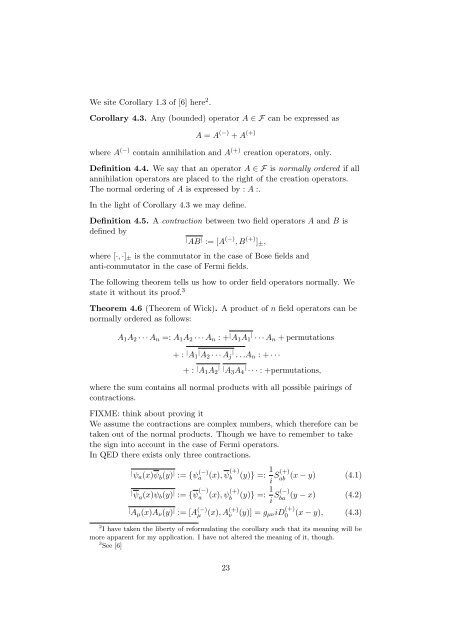Master Dissertation
Master Dissertation
Master Dissertation
You also want an ePaper? Increase the reach of your titles
YUMPU automatically turns print PDFs into web optimized ePapers that Google loves.
We site Corollary 1.3 of [6] here 2 .<br />
Corollary 4.3. Any (bounded) operator A ∈ F can be expressed as<br />
A = A (−) + A (+)<br />
where A (−) contain annihilation and A (+) creation operators, only.<br />
Definition 4.4. We say that an operator A ∈ F is normally ordered if all<br />
annihilation operators are placed to the right of the creation operators.<br />
The normal ordering of A is expressed by : A :.<br />
In the light of Corollary 4.3 we may define.<br />
Definition 4.5. A contraction between two field operators A and B is<br />
defined by<br />
| AB | := [A (−) , B (+) ]±,<br />
where [·, ·]± is the commutator in the case of Bose fields and<br />
anti-commutator in the case of Fermi fields.<br />
The following theorem tells us how to order field operators normally. We<br />
state it without its proof. 3<br />
Theorem 4.6 (Theorem of Wick). A product of n field operators can be<br />
normally ordered as follows:<br />
A1A2 · · · An =: A1A2 · · · An : + | A1A1 | · · · An + permutations<br />
+ : | A1 | A2 · · · Aj | . . .An : + · · ·<br />
+ : | A1A2 | | A3A4 | · · · : +permutations,<br />
where the sum contains all normal products with all possible pairings of<br />
contractions.<br />
FIXME: think about proving it<br />
We assume the contractions are complex numbers, which therefore can be<br />
taken out of the normal products. Though we have to remember to take<br />
the sign into account in the case of Fermi operators.<br />
In QED there exists only three contractions.<br />
| ψa(x)ψb(y) | := {ψ (−)<br />
a (x), ψ (+)<br />
b (y)} =: 1<br />
i S(+)<br />
ab<br />
| ψa(x)ψb(y) | := {ψ (−)<br />
a (x), ψ (+)<br />
b (y)} =: 1<br />
i S(−)<br />
ba<br />
(x − y) (4.1)<br />
(y − x) (4.2)<br />
| Aµ(x)Aν(y) | := [A (−)<br />
µ (x), A (+)<br />
ν (y)] = gµνiD (+)<br />
0 (x − y), (4.3)<br />
2 I have taken the liberty of reformulating the corollary such that its meaning will be<br />
more apparent for my application. I have not altered the meaning of it, though.<br />
3 See [6]<br />
23



